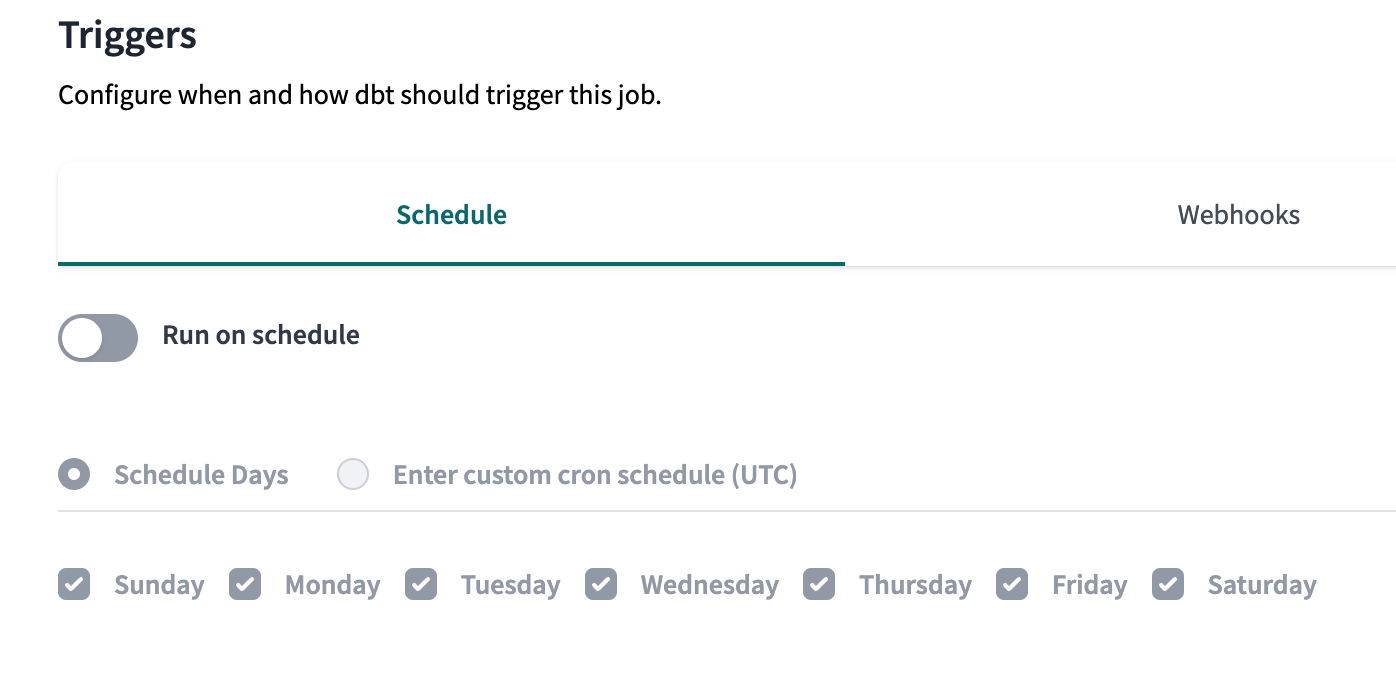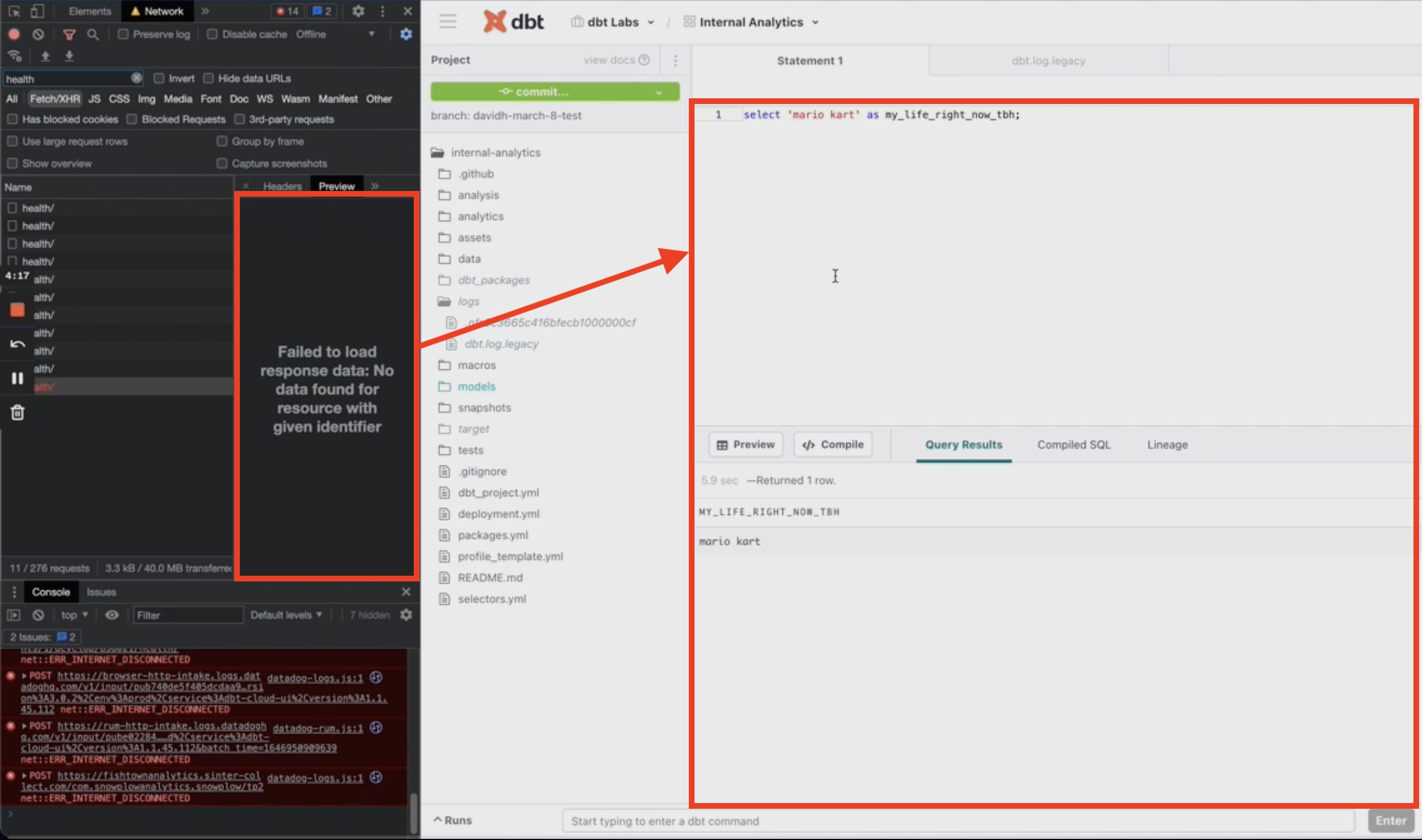2022 dbt Cloud release notes
Archived release notes for dbt Cloud from 2022
December 2022
Threads default value changed to 4
Threads help parallelize node execution in the dbt directed acyclic graph (DAG).
Previously, the thread value defaulted to 1, which can increase the runtime of your project. To help reduce the runtime of your project, the default value for threads in user profiles is now set to 4 threads.
You can supply a custom thread count if you'd prefer more or less parallelization.
For more information, read Understanding threads.
Creating a new job no longer triggers a run by default
To help save compute time, new jobs will no longer be triggered to run by default. When you create a new job in dbt Cloud, you can trigger the job to run by selecting Run on schedule and completing the desired schedule and timing information.
For more information, refer to Deploy jobs.
Private packages must be cloned using access tokens provided by environment variables
The supported method for cloning private GitHub packages is the git token method, where an appropriate access token is passed into the package repository URL with an environment variable.
A small number of people have been able to clone private packages using dbt's native GitHub application without explicitly providing an access token. This functionality is being deprecated as it’s limited in flexibility.
If you have been using a package hosted in a private repository on GitHub, you must start passing an access token into the URL.
An example of passing an access token:
packages:
- git: "https://{{env_var('DBT_ENV_SECRET_GIT_CREDENTIAL')}}@github.com/dbt-labs/awesome_repo.git"
Novemver 2022
The dbt Cloud + Databricks experience is getting even better
dbt Cloud is the easiest and most reliable way to develop and deploy a dbt project. It helps remove complexity while also giving you more features and better performance. A simpler Databricks connection experience with support for Databricks’ Unity Catalog and better modeling defaults is now available for your use.
For all the Databricks customers already using dbt Cloud with the dbt-spark adapter, you can now migrate your connection to the dbt-databricks adapter to get the benefits. Databricks is committed to maintaining and improving the adapter, so this integrated experience will continue to provide the best of dbt and Databricks.
Check out our live blog post to learn more.
Extra features in new and refreshed IDE
The refreshed version of the dbt Cloud IDE has launched four brand-new additional features, making it easier and faster for you to develop in the IDE.
The new features are:
- Formatting — Format your dbt SQL files to a single code style with a click of a button. This uses the tool sqlfmt.
- Git diff view — Highlights the changes in a file before opening a pull request.
- dbt autocomplete — There are four new types of autocomplete features to help you develop faster:
- Use
refto autocomplete your model names - Use
sourceto autocomplete your source name + table name - Use
macroto autocomplete your arguments - Use
env varto autocomplete env var
- Use
- Dark mode — Use dark mode in the dbt Cloud IDE for low-light environments.
Read more about all the Cloud IDE features.
Classic IDE deprecation notice
In December 2022, dbt Labs will deprecate the classic IDE. The new and refreshed IDE will be available for all dbt Cloud users. You will no longer be able to access the classic IDE and dbt Labs might introduce changes that break the classic IDE.
With deprecation, dbt Labs will only support the refreshed version of the dbt Cloud IDE.
Virtual Private Cloud (VPC) customers with questions about when this change will affect your account can contact your account team or support contact for assistance.
October 2022
Announcing dbt Cloud’s native integration with Azure DevOps
dbt Cloud now offers a native integration with Azure DevOps for dbt Cloud customers on the enterprise plan. We built this integration to remove friction, increase security, and unlock net new product experiences for our customers. Setting up the Azure DevOps integration in dbt Cloud provides:
- easy dbt project set up,
- an improved security posture,
- repo permissions enforcement in dbt Cloud IDE, and
- dbt Cloud Slim CI.
Check out our live blog post to learn more!
Introducing a snappier, improved, and powerful Cloud IDE
The new version of the Cloud IDE makes it easy for you to build data models without thinking much about environment setup and configuration.
The new Cloud IDE includes performance upgrades, ergonomics improvements, and some delightful enhancements!
Some of the improvements include:
- Improved Cloud IDE startup time (starting the IDE), interaction time (saving and committing), and reliability.
- Better organization and navigation with features like drag and drop of files, breadcrumb, build button drop-down, and more.
- You can use new features like auto-format your file, auto-complete model names, and git diff view to see your changes before making a pull request.
Read more about the new Cloud IDE features and check out New and improved Cloud IDE blog for more info!
September 2022
List Steps API endpoint deprecation warning
On October 14th, 2022 dbt Labs is deprecating the List Steps API endpoint. From October 14th, any GET requests to this endpoint will fail. Please prepare to stop using the List Steps endpoint as soon as possible.
dbt Labs will continue to maintain the Retrieve Run endpoint, which is a viable alternative depending on the use case.
You can fetch run steps for an individual run with a GET request to the following URL, replacing YOUR_ACCESS_URL with the appropriate Access URL for your region and plan:
https://YOUR_ACCESS_URL/api/v2/accounts/{accountId}/runs/{runId}/?include_related=["run_steps"]
Query the previous three months of data using the metadata API
In order to make the metadata API more scalable and improve its latency, we’ve implemented data retention limits. The metadata API can now query data from the previous three months. For example, if today was March 1, you could query data back to January 1st.
For more information, see Metadata API
August 2022
Support for cross-database sources on Redshift RA3 instances
Cross-database queries for RA3 instances are now supported by dbt Cloud projects using a Redshift connection.
With cross-database queries, you can seamlessly query data from any database in the cluster, regardless of which database you are connected to with dbt.
The connection configuration ra3_node has been defaulted to true. This allows users to:
- benefit from the full RA3 nodes’ capabilities,
- generate appropriate dbt documentation.
July 2022
Large DAG feature
You can now select Render Lineage to visualize large DAGs.
Large DAGs can take a long time (10 or more seconds, if not minutes) to render and can cause browsers to crash.
The new button prevents large DAGs from rendering automatically. Instead, you can select Render Lineage to load the visualization. This should affect about 15% of the DAGs.
May 2022
Refresh expired access tokens in the IDE when using GitLab
On May 22, GitLab changed how they treat OAuth access tokens that don't expire. We updated our IDE logic to handle OAuth token expiration more gracefully. Now, the first time your token expires after 2 hours of consecutive IDE usage, you will have to re-authenticate in GitLab to refresh your expired OAuth access token. We will handle subsequent refreshes for you if you provide the authorization when you re-authenticate.
This additional security layer in the IDE is available only to the dbt Cloud enterprise plan.
April 2022
Audit log
To review actions performed by people in your organization, dbt provides logs of audited user and system events. The dbt Cloud audit log lists events triggered in your organization within the last 90 days.
The audit log includes details such as who performed the action, what the action was, and when it was performed. For more details, review the audit log for dbt Cloud Enterprise documentation.
Credentials no longer accidentally wiped when editing an environment
We resolved a bug where when updating unencrypted fields (e.g. threads, schema name) in an environment setting would cause secret fields (e.g. password, keypair, credential details) to be deleted from that environment. Now users can freely update environment settings without fear of unintentionally wiping credentials.
Email verification
To enhance the security of user creation, dbt Cloud users created using SAML Just-in-Time (JIT) will now confirm identity via email to activate their account. Using email to confirm identity ensures the user still has access to the same email address they use to login via SAML.
Scheduler performance improvements
We rolled out our new distributed scheduler, which has much faster prep times, especially at the top of the hour. We share more about our work and improvements in our product news blog post.
March 2022
Spotty internet issues no longer cause a session time out message
We fixed an issue where a spotty internet connection could cause the “IDE session timed out” message to appear unexpectedly. People using a VPN were most likely to see this issue.
We updated the health check logic so it now excludes client-side connectivity issues from the IDE session check. If you lose your internet connection, we no longer update the health-check state. Now, losing internet connectivity will no longer cause this unexpected message.
Dividing queue time into waiting and prep time
dbt Cloud now shows "waiting time" and "prep time" for a run, which used to be expressed in aggregate as "queue time". Waiting time captures the time dbt Cloud waits to run your job if there isn't an available run slot or if a previous run of the same job is still running. Prep time represents the time it takes dbt Cloud to ready your job to run in your cloud data warehouse.
February 2022
DAG updates and performance improvements
Love the DAG in the IDE as much as we do? Now when you click on a node in the DAG, the model or config file will open as a new tab in the IDE, so you can directly view or edit the code. We'll continue to ship better developer ergonomic functionality throughout the year.
Performance improvements and enhancements
- Updated recommended dbt commands in the IDE to include dbt Core v1.0 commands, such as "build" and the "--select" argument.
Service tokens and bug fixes
Service tokens can now be assigned granular permissions to enforce least privilege access. If you're on Enterprise, you can assign any enterprise permission set to newly issued service tokens. If you're on Teams, you can assign the Job Admin permission set to newly issued service tokens. We highly recommend you re-issue service tokens with these new permissions to increase your security posture! See docs here.
New products and features
- We are joining the GitHub secret scanning partner program to better secure your token against accidental public exposure and potential fraudulent usage.
Bug fixes
- Credentials are no longer accidentally deleted when a user updates an environment setting.
January 2022
Autocomplete snippets for SQL and YAML files in IDE
Some noteworthy improvements include autocomplete snippets for sql and YAML files in the IDE, which are available for use now! We also added a new metric layer page to docs.getdbt.com to help you begin thinking about the metrics layer in dbt Cloud.
Performance improvements and enhancements
- Branch names now default to "main" instead of "master" in new managed and unmanaged Git repositories.
- Update IDE autocomplete snippets.
Model timing for Multi-tenant Team and Enterprise accounts
We started the new year with a gift! Multi-tenant Team and Enterprise accounts can now use the new Model timing tab in dbt Cloud. You can use this tab to further explore long-running models to see if they need refactoring or rescheduling.
Performance improvements and enhancements
- We added client-side naming validation for file or folder creation.



